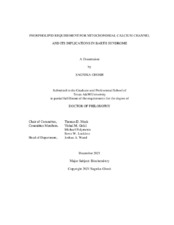| dc.description.abstract | Biochemical interactions between macromolecules form the basis of life. Among different macromolecular interactions present in living systems, we still lag in our understanding of how lipids influence the structure and function of proteins in biological membranes. To this end, I developed yeast Saccharomyces cerevisiae phospholipid mutants as a surrogate system to dissect the in vivo phospholipid requirements of the mitochondrial calcium import machinery – the uniporter complex.
I first focused on mitochondrial calcium uniporter (MCU), the pore-forming subunit of the uniporter complex, for the following reasons. First, it is an integral inner mitochondrial membrane protein that is a key regulator of mitochondrial bioenergetics. Second, MCU is not present in S. cerevisiae, providing a “clean” system to interrogate its phospholipid requirements in a physiologically relevant mitochondrial membrane. Third, mitochondrial calcium signaling has been implicated in a number of human diseases, however, the phospholipid requirements of MCU have remained unknown. I used heterologous expression to functionally reconstitute protozoan and human MCU in wild type yeast as well as in mutants defective in the biosynthesis of the most abundant mitochondrial phospholipids, phosphatidylcholine, phosphatidylethanolamine, or cardiolipin (CL), to uncover a CL-specific requirement for the stability and activity of MCU. My findings from the yeast model system are applicable to higher organisms as shown by the reduced abundance and activity of endogenous MCU in cells and cardiac tissue of Barth syndrome patients that have inherited deficiency in CL levels.
In a follow-up study, I showed that the partial loss of CL in Barth syndrome disease models also results in rapid turnover of mitochondrial calcium uptake 1 (MICU1), the principal regulator of the uniporter complex. The CL-deficiency induced decrease in MCU and MICU1 disrupts mitochondrial calcium signaling such that calcium-stimulated mitochondrial bioenergetic pathways are blunted in cellular models of Barth syndrome. These findings could explain common clinical features observed in Barth syndrome patients such as cardiac arrhythmia and proximal muscle myopathy.
In summary, my work shows that yeast phospholipid mutants can be leveraged to uncover specific phospholipid requirements of mitochondrial membrane proteins and suggests a role of mitochondrial calcium signaling in the pathogenesis of Barth syndrome. | |


